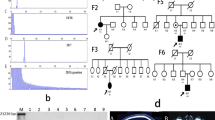Abstract
The spinocerebellar ataxias (SCAs) are a clinically and genetically heterogeneous group of neurodegenerative diseases. Researchers have recently found that SCA type 11 (SCA11) is associated with mutations in the TTBK2 gene. In our previous work, we performed mutation detection in SCA1, 2, 3, 6, 7, 8, 10, 12, 17 and dentatorubral-pallidoluysian atrophy gene in Chinese SCA patients, but the genes responsible for approximately 40% of our patients have not yet been identified. To investigate the frequency of SCA11 in Chinese SCA patients, we examined the TTBK2 gene in 68 unrelated probands diagnosed with dominantly inherited ataxia using the denaturing high-performance liquid chromatography method. All analyzed samples displayed the normal elution profile, which denoted that no disease-related mutation was identified. We provided the evidence that SCA11 is a rare form of ataxia in China.
Similar content being viewed by others
References
Ikeda Y, Dick KA, Weatherspoon MR et al (2006) Spectrin mutations cause spinocerebellar ataxia type 5. Nat Genet 38:184–190
Houlden H, Johnson J, Gardner-Thorpe C et al (2007) Mutations in TTBK2, encoding a kinase implicated in tau phosphorylation, segregate with spinocerebellar ataxia type 11. Nat Genet 39:1434–1436
Waters MF, Minassian NA, Stevanin G et al (2006) Mutations in voltage-gated potassium channel KCNC3 cause degenerative and developmental nervous system phenotypes. Nat Genet 38:447–451
Yabe I, Sasaki H, Chen DH et al (2003) Spinocerebellar ataxia type 14 caused by a mutation in protein kinase C gamma. Arch Neurol 60:1749–1751
Van Swieten JC, Brusse E, de Graaf BM et al (2003) A mutation in the fibroblast growth factor 14 gene is associated with autosomal dominant cerebellar ataxia. Am J Hum Genet 72:191–199
Ishikawa K, Toru S, Tsunemi T et al (2005) An autosomal dominant cerebellar ataxia linked to chromosome 16q22.1 is associated with a single nucleotide substitution in the 5-prime untranslated region of the gene encoding a protein with spectrin repeat and Rho guanine nucleotide exchange factor domains. Am J Hum Genet 77:280–296
Iwaki A, Kawano Y, Miura S et al (2008) Heterozygons deletion of ITPR1, but not SUMF1, in spinocerebellar ataxia type 16. J Med Genet 45:32–35
Gardner RJM (2008) “SCA16” is really SCA15. J Med Genet 45:192
Worth PF, Giunti P, Gardner-Thorpe C et al (1999) Autosomal dominant cerebellar ataxia type III: linkage in a large British family to a 7.6-cM region on chromosome 15q14–21.3. Am J Hum Genet 65:420–426
Johnson J, Wood N, Giunti P, Houlden H (2008) Clinical and genetic analysis of spinocerebellar ataxia type 11. Cerebellum 7:159–164
Tang BS, Liu CY, Shen L et al (2000) Frequency of SCA1, SCA2, SCA3/MJD, SCA6, SCA7, and DRPLA CAG trinucleotide repeat expansion in patients with hereditary spinocerebellar ataxia from Chinese kindreds. Arch Neurol 57:540–544
Wang JL, Jiang H, Zhang S et al (2008) Lack of variation of ATTCT pentanucleotide repeats at ATXN10 gene between clinically diagnosed ataxia patients and normal individuals originated from Chinese Han. J Genet 87:283–286
Harding AE, Deufel T (1993) Clinical features and classification of inherited ataxias. In: Harding AE, Deufel T (eds) Inherited ataxias. Raven, New York, pp 1–14
Kosaki K, Udaka T, Okuyama T (2005) DHPLC in clinical molecular diagnostic services. Mol Genet Metab 86:117–123
Crépin M, Pigny P, Escande F et al (2006) Evaluation of denaturing high performance liquid chromatography for the mutational analysis of the MEN1 gene. J Mol Endocrinol 36:369–376
Acknowledgments
We thank the participating patients for their cooperation. This study was supported by a grant from the National 863 High-tech Project (No. 2006AA02A408), a grant from the National Basic Research Program (973 program) (No. 2006cb500700), a grant from the National Science and Technology Support Project of “the Eleventh Five-year Plan” (No. 2006BAI05A07) and grants from the National Natural Science Foundation of China (30681151 and 30400262).
Author information
Authors and Affiliations
Corresponding author
Rights and permissions
About this article
Cite this article
Xu, Q., Li, X., Wang, J. et al. Spinocerebellar ataxia type 11 in the Chinese Han population. Neurol Sci 31, 107–109 (2010). https://doi.org/10.1007/s10072-009-0129-4
Received:
Accepted:
Published:
Issue Date:
DOI: https://doi.org/10.1007/s10072-009-0129-4




